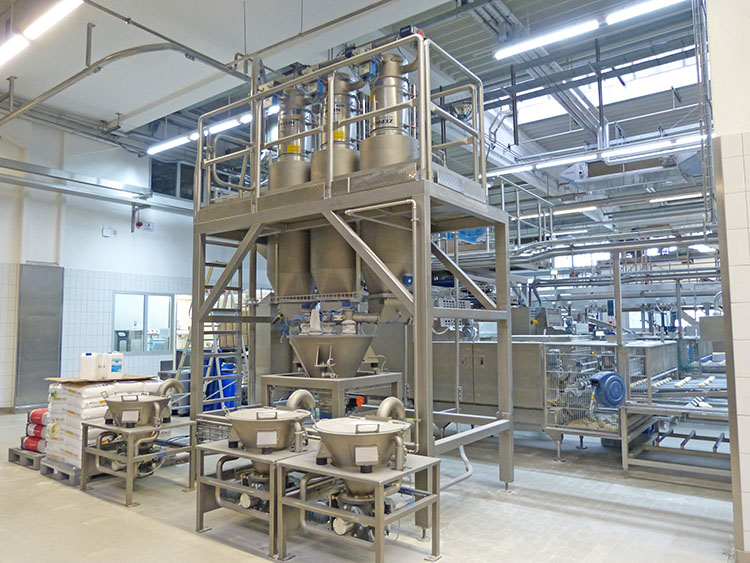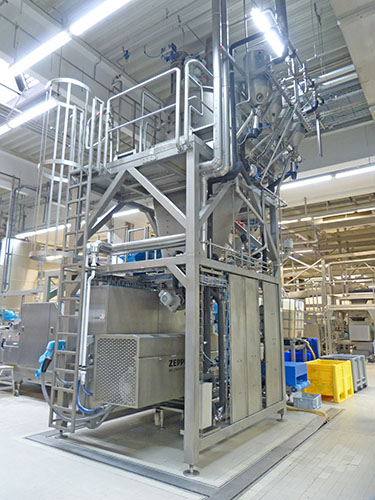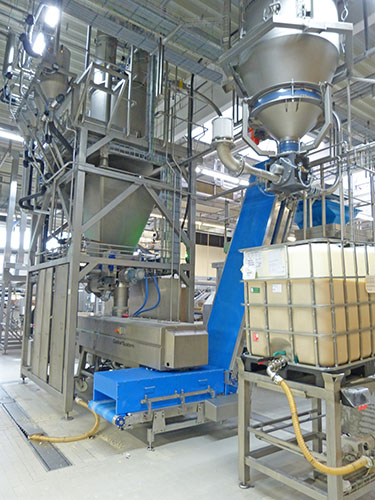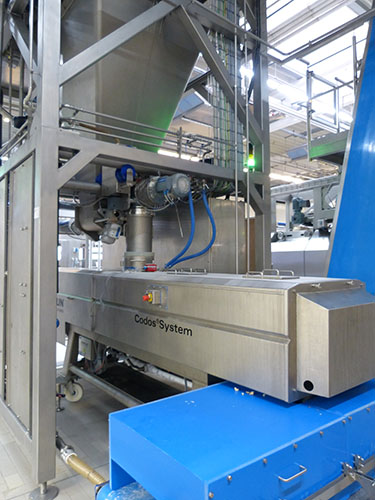
The Ditsch GmbH pretzel bakery has invested in a new DymoMix system at its Oranienbaum site. Processing tolerance of the wheat doughs has already improved. The next scheduled step is to increase dough yield.
For Matthias Hartung, Oranienbaum Works Manager, and Matthias Grollmisch, Engineering Manager, Brezelbäckerei Ditsch GmbH, this is the first line from the systems engineering supplier Zeppelin Systems GmbH. The DymoMix system, together with a Codos mixer, has been operating to produce wheat doughs continuously in 3-shift operation for around seven months. The two experts were convinced firstly by the line’s very small footprint to produce doughs continuously on a few square meters, and secondly the dough quality was also improved. Matthias Grollmisch says “The DymoMix wetting system makes doughs for bread rolls and sticks more uniform and easier to process by machine.” Matthias Hartung adds “The system also saves around 40% of the mixing and kneading time, and the dough develops faster.” Work is currently underway to increase the dough yield. The DymoMix wetting system developed by Zeppelin, which operates as a pre-mixer in Oranienbaum, successfully achieved this. The system wets powdered raw materials such as flour, sugar and baking agent with water, forming a homogeneous dough instantly. Wetting with water takes place through a specially developed nozzle integrated into the rotating shaft of the DymoMix.
So much energy is input by the impact of the water on the dry materials and an initial mixing by metal rods fixed to the shaft below that not only is the flour wetted, but also a gluten network is initiated. Matthias Grollmisch, Head of Engineering, assumes the dough from the DymoMix is already almost fully kneaded, and that the process generally leads to faster dough development.
Control
The DymoMix is also positioned directly above a Codos mixer. This allows raw materials to move continuously into the mixing compartment underneath, where the dough is fully kneaded to the required consistency. The temperature of the raw materials and dough is constantly measured during the entire process steps. Dough temperature is controllable via the temperature of the added water and the cooling jacket installed on the mixer. Describing the line’s special features, Works Manager Matthias Hartung says “Zeppelin individually readapted our plate heat exchanger.” Cooling medium is circulated via a control unit mounted on the Codos, which regulates the double jacket to the required set-point temperature. Another special feature is that due to the structural arrangements, the flour storage tank stands alongside the line, exactly like the small components line.

Small components are weighed automatically
Interview FAQ’s
Questions to Matthias Grollmisch, Engineering Manager, Ditsch GmbH pretzel bakery, Oranienbaum works
BBI: Why did you decide in favor of a continuous line?
Grollmisch: The robust mechanical engineering and the dough qualities for our special applications demonstrated in test runs gave us confidence in the design concept of Zeppelin’s continuous mixer.
BBI: What were the preconditions, or what was the line required to be capable of?
Grollmisch: Continuous dough production with our specific requirements regarding consistency, processability and dough temperature were the basic requirement for the purchase decision.
BBI: In your view, what are the line’s special features?
Grollmisch: The compact construction and small footprint requirement, together with the combination of a DymoMix with a Codos and the associated opportunities for absorption of water into the dough.
BBI: What distinguishes the line from other machines?
Grollmisch: The main difference is the amount of water absorption that is possible with the same consistency/processability.
BBI: Where and how does post-kneading take place?
Grollmisch: What comes out of the entire system is a fully-kneaded dough, so post-kneading is unnecessary.
BBI: What is the situation regarding dough heating?
Grollmisch: We defined the dough temperature with Zeppelin in the run-up. Dough heating is counteracted by adding ice-water and by active mixer jacket cooling.
BBI: What kind of doughs currently run through the line?
Grollmisch: Exclusively doughs for lye products.
BBI: How long was needed for installation and commissioning?
Grollmisch: Approximately three months.
BBI: What is the line’s hourly capacity?
Grollmisch: Around 3,200 kg of dough.
BBI: How many employees work in Oranienbaum?
Grollmisch: 395 (as on 27.2.2018)
BBI: Do they work three shifts?
Grollmisch: Yes, and also partly into the weekend.
BBI: Which products do the staff manufacture?
Grollmisch: We produce lye baked products in various shapes, e.g. pretzels, bread rolls, sticks, knots, plaits, pizzas and croissants. The lye pretzels, for example, range from 50 g to 1,800 g. Among convenience products, we offer pre-proofed dough pieces and fully-baked products, each frozen.
BBI: How many lines are now operating?
Grollmisch: We currently have 8 lines operating in Oranienbaum.
Generally speaking, Zeppelin integrates control of the metering and dough production into a higher-level process control system. The required machine parameters (e.g. rotation speeds, temperatures, pressures etc.) together with the recipe parameters for the respective operating modes are transferred from the process control system to the mixer via the interface. Starting and stopping the line can either be manually at the control panel, or by signal exchange from the downstream lines, or centrally from the process control system. At Ditsch, the fully kneaded dough is carried on a conveyor belt to further processing steps.
For cleaning, the DymoMix is disconnected from the Codos, swiveled out, and the protective tube removed. The latter goes into a washroom, while the DymoMix tools are cleaned manually in situ. The inlet pipe is removed from the Codos and also goes into the washroom, where it is afterwards cleaned internally by four ceiling-mounted directed-jet cleaners. Upstream of the directed-jet cleaners there are three disk valves that distribute the water to the cleaners by alternately switching, thus increasing the cleaning effect. In general, installing the new system enabled the mixing process at Ditsch GmbH to be optimized.


General view of the line: the DymoMix-System is in the upper area, with the continuous mixer below. Hourly capacity is around 3,200 kg of dough

After mixing, the wheat dough is transferred to a conveyor belt, and further processing takes place

The line’s control panel. Parameters such as pressures, temperature or rotation speed can be set


